| Listing 1 - 6 of 6 |
Sort by
|
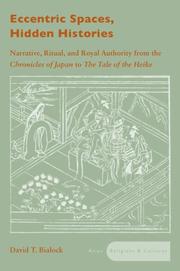
ISBN: 0804751587 9780804751582 0804767645 1435608801 9781435608801 Year: 2007 Publisher: Stanford, Calif. : Stanford University Press,
Abstract | Keywords | Export | Availability | Bookmark
 Loading...
Loading...Choose an application
- Reference Manager
- EndNote
- RefWorks (Direct export to RefWorks)
After 'The Tale of Genji' (c.1000), the greatest work of classical Japanese literature is the historical narrative 'The Tale of the Heike' (13th-14th centuries). In addition to opening up fresh perspectives on the Heike narratives, this study draws attention to a range of problems centred on the interrelationship between narrative, ritual space, and Japan's changing views of China as they bear on depictions of the emperor's authority, warriors, and marginal population going all the way back to the Nara period.
History in literature. --- Japanese literature --- Religion and literature --- History and criticism. --- Heike monogatari. --- J5500.10 --- J5920 --- Literature --- Literature and religion --- Japan: Literature -- history and criticism -- premodern, ancient and earliest --- Japan: Literature -- premodern fiction and prose ( -1868) --- Moral and religious aspects --- Tale of the Heike --- 平家物語 --- History in literature --- History and criticism
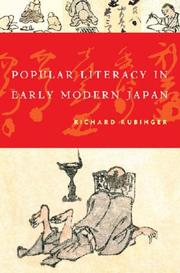
ISBN: 9780824830267 9780824831240 Year: 2007 Publisher: Honolulu (Hawaii) : University of Hawaii press,
Abstract | Keywords | Export | Availability | Bookmark
 Loading...
Loading...Choose an application
- Reference Manager
- EndNote
- RefWorks (Direct export to RefWorks)
History of Asia --- History of civilization --- anno 1700-1799 --- anno 1800-1999 --- anno 1600-1699 --- Japan --- Literacy --- Popular education --- History. --- Critical theory --- Non-formal education --- Community education --- Critical pedagogy --- Illiteracy --- Education --- General education --- J5000.60 --- J5500.60 --- J4900.60 --- Japan: Language -- history -- Kinsei, Edo, Tokugawa period, early modern (1600-1867) --- Japan: Literature -- history and criticism -- Kinsei, Edo, Tokugawa period, early modern (1600-1867) --- Japan: Education -- history -- Kinsei, Edo, Tokugawa period, early modern (1600-1867) --- History
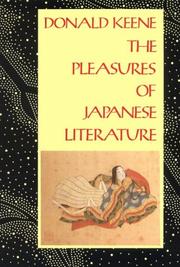
ISBN: 9780231067362 9780231067379 0231067364 Year: 2007 Publisher: New York Columbia university press
Abstract | Keywords | Export | Availability | Bookmark
 Loading...
Loading...Choose an application
- Reference Manager
- EndNote
- RefWorks (Direct export to RefWorks)
Perhaps no one is more qualified to write about Japanese culture than Donald Keene, considered the leading interpreter of that nation's literature to the Western world. The author, editor, or translator of nearly three dozen books of criticism and works of literature, Keene now offers an enjoyable and beautifully written introduction to traditional Japanese culture for the general reader.The book acquaints the reader with Japanese aesthetics, poetry, fiction, and theater, and offers Keene's appreciations of these topics. Based on lectures given at the New York Public Library, The Metropolitan Museum of Art, and the University of California, Los Angeles, the essays -though written by a renowned scholar- presuppose no knowledge of Japanese culture. Keene's deep learning, in fact, enables him to construct an overview as delightful to read as it is informative.His insights often illuminate aspects of traditional Japanese culture that endure today. One of these is the appreciation of "perishability." this appreciation os seen in countless little bits of Japanese life: in temples made of wood instead of durable materials; in the preference for objects -such as pottery- that are worn, broken, or used rather than new; and in the national love of the delicate cherry blossom, which normally falls after a brief three days of flowering. Keene quotes the fourteenth-century Buddhist monk Kenko, who wrote that "the most precious thing about life is its uncertainty."Throughout the volume, Keene demonstrates that the rich artistic and social traditions of Japan can indeed be understood by readers from our culture. This book will enlighten anyone interested in Japanese literature and culture.
J5500.10 --- J6800.10 --- J6020 --- J5920 --- Japanese literature --- -Theater --- -Aesthetics, Japanese --- Japanese aesthetics --- Dramatics --- Histrionics --- Professional theater --- Stage --- Theatre --- Performing arts --- Acting --- Actors --- Japan: Literature -- history and criticism -- premodern, ancient and earliest --- Japan: Performing and media arts -- history -- earliest and premodern --- Japan: Art and antiquities -- Japanese aesthetics (Japonism) --- Japan: Literature -- premodern fiction and prose ( -1868) --- History and criticism --- History --- Japanese literature - To 1868 - History and criticism --- Theater - Japan - History --- Aesthetics, Japanese --- Theater --- Aesthetics, Japanese. --- History and criticism. --- History.
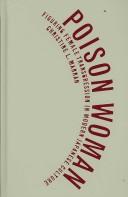
ISBN: 9780816647262 0816647267 9780816647279 0816647275 Year: 2007 Publisher: Minneapolis University of Minnesota Press
Abstract | Keywords | Export | Availability | Bookmark
 Loading...
Loading...Choose an application
- Reference Manager
- EndNote
- RefWorks (Direct export to RefWorks)
Based on the lives and crimes of no less than twenty real women, dokufu (poison women) narratives emerged as a powerful presence in Japan during the 1870s. During this tumultuous time, as the nation moved from feudalism to oligarchic government, such accounts articulated the politics and position of underclass women, sexual morality, and female suffrage. Over the next century, the figure of the oversexed female criminal, usually guilty of robbery or murder, became ubiquitous in modern Japanese culture. In Poison Woman, Christine L. Marran investigates this powerful icon, its shifting meanings, and its influence on defining women's sexuality and place in Japan. She begins by considering Meiji gesaku literature, in which female criminality was often medically defined and marginalized as abnormal. She describes the small newspapers (koshinbun) that originally reported on poison women, establishing journalistic and legal conventions for future fiction about them. She examines zange, or confessional narratives, of female and male ex-convicts from the turn of the century, then reveals how medical and psychoanalytical literature of the 1920s and 1930s offered contradictory explanations of the female criminal as an everywoman or a historical victim of social circumstances and the press. She concludes by exploring postwar pulp fiction (kasutori), film and underground theater of the 1970s, and the feminist writer Tomioka Taeko's take on the transgressive woman. Persistent stories about poison women illustrate how a few violent acts by women were transformed into myriad ideological, social, and moral tales that deployed notions of female sexual desire and womanhood. Bringing together literary criticism, the history of science, media theory, and gender and sexuality studies, Poison Woman delves into genre and gender in ways that implicate both in projects of nation-building.
Villains in popular culture --- Women in popular culture --- Women --- Social conditions. --- Japan --- Civilization --- Criminology. Victimology --- Sociology of culture --- Fiction --- Film --- Sexology --- Sociology of the family. Sociology of sexuality --- Mass communications --- J4176.80 --- J4000.70 --- J5500.70 --- J5930 --- Popular culture --- Social conditions --- Japan: Sociology and anthropology -- gender roles, women, feminism -- history --- Japan: Social history, history of civilization -- Kindai (1850s- ), bakumatsu, Meiji, Taishō --- Japan: Literature -- history and criticism -- modern, Kindai (1850s- ), bakumatsu, Meiji, Taishō --- Japan: Literature -- modern fiction and prose (1868- ) --- Public opinion --- Movies --- Literature --- Media --- Sexuality --- Images of women --- Book --- Criminality --- Culture
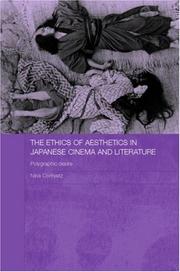
ISBN: 0415770874 9780415770873 9780203967010 9781135985080 9781135985127 9781135985134 9780415474603 Year: 2007 Publisher: London Routledge
Abstract | Keywords | Export | Availability | Bookmark
 Loading...
Loading...Choose an application
- Reference Manager
- EndNote
- RefWorks (Direct export to RefWorks)
'The Ethics of Aesthetics in Japanese Cinema and Literature' is a study of the ethics of modern Japanese aesthetics from the 1930s, through WWII and into the postwar period. What makes this book unique is that Nina Cornyetz opens up the field in new and controversial ways by exploring the tensions and harmonies between psychoanalytic ethics of the drive and socio-political ethics of relation to the other. Rejecting the convention of viewing these as contradictory, Cornyetz insists that the exemplars of psychoanalytic ethics are to the contrary, simultaneously politically ethical. Cornyetz embarks on innovative and unprecedented readings of some of the most significant literary and film texts of the Japanese canon, including works by Kawabata Yasunari, Mishima Yukio, Abe Kb and Shinoda Masahiro, all renowned for their texts' aesthetic and philosophic brilliance. The study looks at how relations between individuals and communities in these texts either reiterate or transcend stereotypes, and how desire is or is not limited by sociocultural norms. Cornyetz argues that these authors' and filmmakers' concepts of beauty and relation to others were, in fact, deeply impacted by political and social factors. Ranging from a discussion of fascist aesthetics to heterosexism in modern Japan, 'The Ethics of Aesthetics in Japanese Cinema and Literature' shows how certain changing political, intellectual and artistic issues, as well as sociocultural norms, variously nuanced these texts' depictions of desire and the 'other'. Through her analysis of cultural texts such as the films 'Woman in the Dunes' and 'Double Suicide', Cornyetz challenges the convention that praises the universality of their artistic, existential or intellectual achievements. Rather she seeks to reorient these within a specifically Japanese historical context to give a new and insightful interpretation to the work. This ground breaking study is truly interdisciplinary and will appeal to students and scholar
J5931 --- J5500.80 --- J5509 --- J6839 --- J6020 --- Authors, Japanese --- -Literature and morals --- Motion pictures --- -Motion pictures --- -Cinema --- Feature films --- Films --- Movies --- Moving-pictures --- Audio-visual materials --- Mass media --- Performing arts --- Literature --- Morals and literature --- Ethics --- Japanese authors --- Japan: Literature -- modern fiction and prose (1868- ) -- criticism --- Japan: Literature -- history and criticism -- Gendai (1926- ), Shōwa period, 20th century --- Japan: Literature -- theory, methodology and philosophy --- Japan: Media arts and entertainment -- cinema --- Japan: Art and antiquities -- Japanese aesthetics (Japonism) --- Aesthetics. --- Aesthetics --- History and criticism --- Influence --- Moral and ethical aspects --- Literature and morals --- Literature and morals.
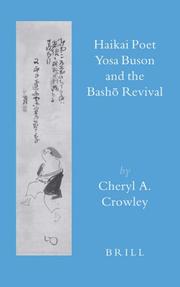
ISBN: 9004157093 9789004157095 9786611458300 1281458309 9047411919 9789047411918 9781281458308 6611458301 Year: 2007 Volume: 27 Publisher: Leiden ; Boston : Brill,
Abstract | Keywords | Export | Availability | Bookmark
 Loading...
Loading...Choose an application
- Reference Manager
- EndNote
- RefWorks (Direct export to RefWorks)
This book uses the haikai verse and paintings of the brilliant, innovative artist Yosa Buson (1716-1783) as a focal point from which to explore how Japanese writers competed for artistic authority in a time when popular responses to economic, technological, and social changes were creating the beginnings of a modern literature. The first part of the book discusses Buson's role in the Bashō Revival movement, situating his haikai in the context of the social networks that writers of his time both relied on and resisted. The second part explores Buson's hokku , linked verse, and haiga (haikai painting). The book concludes with a discussion of Buson's reception in the modern period, and includes translations of his principal works.
J5730 --- J5500.60 --- J2284.60 --- Japan: Literature -- poetry -- haiku, haikai --- Japan: Literature -- history and criticism -- Kinsei, Edo, Tokugawa period, early modern (1600-1867) --- Japan: Genealogy and biography -- biographies -- Kinsei, Edo, Tokugawa period, early modern (1600-1867) --- Haikai --- Japanese poetry --- History and criticism --- Matsuo, Bashō, --- Yosa, Buson, --- Taniguchi, Chōkō, --- Buson, --- Sha, Shunsai, --- Taniguchi, Buson, --- Buson, Yosa, --- 与謝無村, --- 与謝蕉村, --- 与謝蕪材, --- 与謝蕪村, --- 与谢蕪村, --- 與謝無村, --- 與謝蕪村, --- 谷口蕪村, --- Matsuo, Munefusa, --- Bashō, --- Bashō-ō, --- Tōsei, --- Hakusendō, --- Tentenken, --- Katōten, --- Katōen, --- Hōbi, --- Yōkaku, --- Bashōan Tōsei, --- Mat︠s︡uo, Basë, --- Bashō, Matsuo, --- Matsuo, Basyo, --- Basyo, --- Matsuo, Kinsaku, --- Басë, Мацуо, --- בשו --- 与谢芭蕉, --- 松尾笆蕉, --- 松尾芭焦, --- 松尾芭蕉, --- 松尾芭蕪, --- 松尾蕉, --- 芭蕉, --- 麻生磯次, --- Matsuo, Bashō --- Bashō, Matsuo --- History and criticism. --- Matsuo, Bashō, --- Taniguchi, Chōkō --- Sha, Shunsai --- Buson, Yosa --- Buson --- Taniguchi, Buson --- 与謝無村 --- 与謝蕉村 --- 与謝蕪材 --- 与謝蕪村 --- 与谢蕪村 --- 與謝無村 --- 與謝蕪村 --- 谷口蕪村 --- 松尾, 芭蕉
| Listing 1 - 6 of 6 |
Sort by
|

 Search
Search Feedback
Feedback About
About Help
Help News
News